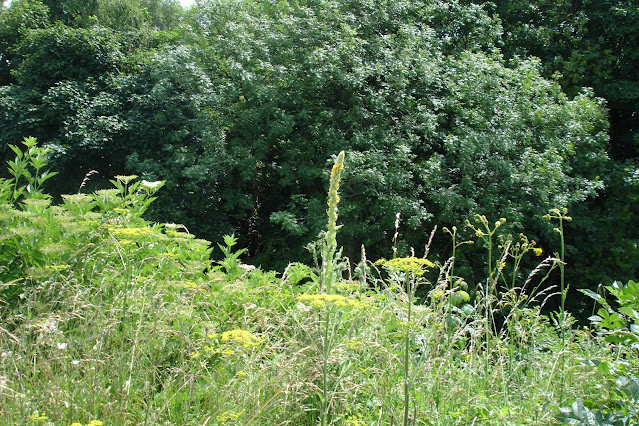Scrambled thoughts on the Roman Bartlow Mounds. A glorious day, Essex in full pastoral glory, looking sweet and pretty with its thatched cottages, the fields full of wheat, some turning a soft sheen of pale gold under the sun. No cows of course, something I miss in this wheat region. But what lies under the surface, well we had a delicious meal in the pub at Bartlow, chatted to the landlord, and he filled us in on house prices. Let us say that it is expensive to live in this county, the building plot in the derelict kitchen gardens had cost a minor £900,000 for the land, was not sure about the building of it. A large house with three acres had just sold (sealed bids) for four million pounds and he reckoned a further few hundred thousand to update it, a two bedroom cottage in the village had gone in four minutes for approximately £300,000. Crazy prices, probably London money all to live in an idyllic bucolic dream, we need a socialist answer!
But to return from the gossip, to the reason we visited, as we approach the little round towered church, my first impression always is, path to the left pagan, path to the right Christian, under the rampant sweet pea at the gate of the church are the remains of an old tree stump, and when you walk down the cool path to the mounds you will meet tree giants along the way, as if in an avenue of great trees, an earlier history of the manor probably. But also an old bridge across a stream and another bridge for the defunct railway line. Past the old kitchen gardens with their large greenhouses falling into disrepair, and then you turn the corner and a great mound greets you, the largest is about 40 feet high, the three mounds hemmed in by the trees and a paling fence, so that it is difficult to photograph. For me this small area of a pagan past is so resolute with history that the imagination could run riot. A green tree cathedral for the mounds of these Roman 1st century immigrants, with the hint of a Roman feast buried deep below the chalk. Evidence does not survive because the place where the pottery, etc was lodged in the 19th/20th had burnt down.
As the village lies just on this side of the border between Essex and Cambridgeshire, it is Cambridgeshire Council who look after it, the grass was roughly mown and the tree saplings had been cut down on the sides of the mound, a difficult job given the steepness of the sides of the mounds, perhaps they used ropes to tether themselves.
I have written elsewhere on an earlier visit, so this must be speculation, was it slave labour of the local British inhabitants to dig and build these monuments I wonder... anyway Wiki notes.
"For centuries the mounds were believed to cover the bodies of those killed at the Battle of Ashingdon in 1016, but excavation demonstrated that they are the graves of a wealthy family and date from the 1st or 2nd century AD. Excavations in the 19th century found large wooden chests, decorated vessels in bronze, glass and pottery and an iron folding chair, most of which were lost in a later fire at Bartlow Hall. A small Roman villa, occupied until the late 4th century, was situated north of the mounds and was excavated in 1852."
 |
| This is an aerial view by Bill Blake |
 |
| I will always remember how hot the sun was when we wandered into the cool interior of the church. |
 |
| The three barrows were like great shaggy beasts greeting you |
We went back several times, once even on a solstice, to this magical place buried deep in the countryside. Always quiet, in summer, butterflies dancing around and the barrows having a covering of wild flowers.










What a strange combination for Roman? burials. Were those not "bunged in" later? How very peculiar. I wonder what the age of the paleosol was?
ReplyDeleteDefinitely Roman, think they came over from the continent where similar barrows can be found. I will look for further information but they are fascinating. Had to look up 'paleosol' by the way. One of the reasons there is less prehistory in Essex is because there is no visible rocky surfaces, plenty of soil though.
ReplyDeleteThe size is staggering. I wonder what more is to be learned. I would know it all, if I could.
ReplyDeleteProblem is Joanne you have to burrow into it but there is a lot of archaeological history around them.
Delete